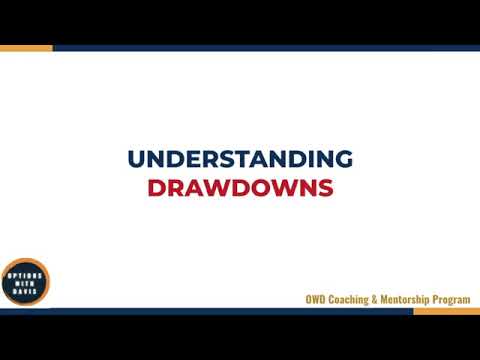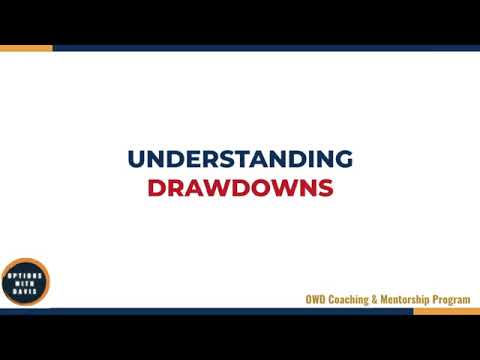In this video titled “4-8 Understanding Drawdowns,” we’ll be discussing the concept of drawdowns in trading and why they are a normal part of the process. Drawdowns occur when the market moves against your positions, resulting in losses. It’s important to keep calm and avoid panicking during drawdowns, allowing your trades to play out. We’ll also explore how drawdowns can still happen even if the market hasn’t reached your short strikes. Additionally, we’ll emphasize the importance of not trading too many different underlyings simultaneously, as they can move in tandem and lead to multiple positions being hit at the same time. Staggering entries and focusing on a handful of underlyings can help minimize drawdowns. Remember, the true probability of a strategy is determined over the long term and not based on a few trades, so don’t let short-term losses discourage you. Stay tuned to learn more about effectively managing drawdowns and maintaining a successful trading strategy.
1. Understanding Drawdowns
Drawdowns are a common occurrence in trading and are a normal part of the process. They occur when the market moves against your positions, resulting in losses. It is important to understand and manage drawdowns to navigate through the ups and downs of trading successfully.
2. Definition of Drawdowns
2.1 What are drawdowns in trading?
Drawdowns in trading refer to the decline in the value of an investment or trading account from its peak value. They represent the losses incurred during a specific period, usually expressed as a percentage, and can be caused by factors such as market conditions, individual trade performance, or external events.
2.2 Causes of drawdowns
Drawdowns can be caused by various factors, including market volatility, unfavorable market movements, unexpected news or events, and poor trade execution. It is essential to understand the reasons behind drawdowns to make informed decisions and develop strategies to manage them effectively.

3. Importance of Managing Drawdowns
3.1 The normality of drawdowns
Drawdowns are a normal part of trading and should be expected. Even the most successful traders experience drawdowns at some point in their careers. Understanding and accepting that drawdowns are a natural occurrence can help reduce anxiety and emotional reactions during challenging trading periods.
3.2 Not panicking during drawdowns
It is crucial not to panic when facing drawdowns. Succumbing to panic can lead to impulsive decision-making and potentially exacerbate losses. Instead, it is important to stay calm, review your trading strategy, and evaluate the reasons behind the drawdown. By maintaining a calm and rational approach, you can make more informed decisions to navigate through drawdowns effectively.
3.3 Allowing trades to play out
During drawdowns, it is important to allow your trades to play out according to your trading plan. Trying to prematurely exit positions out of fear can lead to missed opportunities for potential recovery. By sticking to your trading plan and allowing trades to run their course, you give yourself a chance to recover from drawdowns and potentially turn them into profitable trades.
4. Factors Affecting Drawdowns
4.1 Drawdowns even without reaching short strikes
Drawdowns can occur even if the market has not reached your short strikes. This is because drawdowns are influenced by various factors, including market movements, volatility, and overall trade performance. Understanding that drawdowns can happen regardless of specific strike levels helps manage expectations and avoid unnecessary panic.
4.2 Impact of trading too many different underlyings
Trading too many different underlyings can increase the likelihood of experiencing drawdowns. When multiple positions are opened on various underlyings, they can move in tandem, resulting in multiple positions being hit simultaneously during market downturns. To minimize drawdowns, it is advisable to focus on a few core underlyings instead of spreading yourself too thin across multiple ones.
4.3 Drawdowns on initial positions during market downturns
During market downturns, drawdowns can occur on initial positions. This is because when the market moves to lower levels, the value of the positions may decline temporarily. It is important to be prepared for such drawdowns and not let short-term fluctuations affect your long-term trading strategy.
5. Strategies to Minimize Drawdowns
5.1 Staggering entries for minimizing drawdowns
To minimize drawdowns, one effective strategy is to stagger entries. Instead of opening all positions at once, spread them out over a period of time. By staggering entries, you reduce the risk of being heavily exposed to market movements and potential drawdowns. This strategy allows you to manage your trades more effectively and mitigate losses.
5.2 Determining true probability over the long term
Instead of judging the success of a trading strategy based on a few trades, it is important to evaluate it over the long term. The true probability of a strategy can only be determined through a large sample size of trades. By focusing on the long-term performance and maintaining discipline, you can better evaluate the effectiveness of your strategy and manage drawdowns accordingly.
5.3 Win rate and its averaging effect over multiple trades
It is important to understand that the win rate of a trading strategy may vary in the short term but tends to average out over a larger number of trades. This means that even during periods of drawdowns or losses, maintaining discipline and sticking to your strategy can help achieve positive results in the long run. By focusing on the overall performance and not getting discouraged by temporary setbacks, you can minimize drawdowns and increase the probability of success.
5.4 Risks of trading too many underlyings
Trading too many underlyings can lead to thin stretched positions and increased drawdowns. When you spread yourself too thin across multiple underlyings, it becomes challenging to monitor and manage each position effectively. By focusing on a select number of core underlyings, you can allocate your resources more efficiently and reduce the risk of excessive drawdowns.
6. Conclusion
Understanding drawdowns and managing them effectively is an important aspect of successful trading. Drawdowns are a normal part of the trading process and should be expected. By not panicking during drawdowns, allowing trades to play out, and implementing strategies to minimize drawdowns, you can navigate through challenging periods with confidence and increase your chances of long-term success. Remember to focus on the bigger picture, evaluate your strategy over the long term, and stay disciplined in your trading approach.
